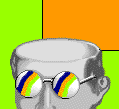| 
|
|
50
Uses for Inspiration® and KidspirationTM
|
- Assist students in organizing information
- Assist teachers in planning lessons/units/themes
- Illustrate school's goals or plan for Parent-Teacher
Organization
- Illustrate instructional goal links to testing
expectations
- To show what each grade will be teaching and how
units fit into the larger picture of curriculum
for the whole school
- Assess student learning
- Show integration of different topics across the
curriculum for a unit, lesson, or long-range plan
- Present difficult material in a step by step manner
- Plot summaries
- Create cause/effect/solution diagrams to resolve
social issues within the classroom
- Book design elements
- Illustrate digestive system
- Local government diagram
- Defining new terms
- Introducing a new concept
- Note-taking organizer
- Detailed processes (how to add polynomials etc.)
- Creating storyboards for Powerpoint and Hyperstudio
presentations
- Comparison activities
- Historical cause and effect
- Cycles (recycle, weather, etc.)
- To construct a food chain
- Map of where items are stored in desk, trapper,
or locker
- Library orientation
- Language Arts - character descriptions, plot movement,
action that leads to the climax
- Math-to teach algorithms (especially division)
- Math-problem solving because it is non-linear
- Create instructions for games
- Create picture charts that students can follow
if they are communication impaired. Kids can follow
picture symbols such as the symbols found on the
Mayer-Johnson Boardmaker software.
- Help study for a test.
- Classroom organization chart with associated responsibilities
- How to/step by step for learning new software
- Developing a course or workshop
- Planning a WebQuest
- Documenting job responsibilities
- Planning a Web site
- Personal professional goals
- Concept maps to send home to parents to help explain
a unit so they can help their children study/review
- Assist cooperative groups in defining projects
and dividing job responsibilities.
- Faculty/district - responsibilities of committees
- Flow charts for behavior plans for either the
classroom or a specific student
- Similarities between different units through the
use of the same structure in the graphic organizer.
- A tool for students to identify when they do not
understand information and identify the where the
breakdown is in their comprehension.
- To add more depth in a compare/contrast lesson,
for example, identifying the important variables
by color-coding or other visual element, and then
deciding if the variable is the same or different
in the two objects of study.
- Showing relationships.
- Procedures to follow during an emergency drill
such as a fire or storm drill;
- Lab procedure explanation
- To present lab conclusions and highlight important
concepts (especially prior to completing a written
explanation)
- In foreign language classes create an organizer
that shows the English word on one side and the
foreign language word equivalent on the other side
with pictures as hints.
- When studying a poem, in the center concept list
the name of the poem and the connecting lines contain
phrases from the poem. The subconcept explains the
words in the phrase and the literary technique used
such as personification.
|
|
| |
|